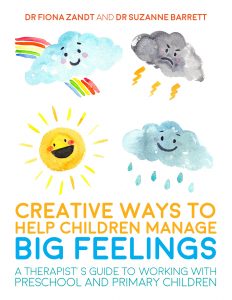 Dr Fiona Zandt has written the below article on the importance of play in therapy. Dr Fiona Zandt and Dr Suzanne Barrett, authors of Creative Ways to Help Children Manage BIG Feelings, are clinical psychologists who currently work in successful private practices in Melbourne. They each have over 15 years’ experience working with children and families.
Dr Fiona Zandt has written the below article on the importance of play in therapy. Dr Fiona Zandt and Dr Suzanne Barrett, authors of Creative Ways to Help Children Manage BIG Feelings, are clinical psychologists who currently work in successful private practices in Melbourne. They each have over 15 years’ experience working with children and families.
Connecting families with wool – Why play is so important when working therapeutically with children
A therapist recently described using an activity from our book that involves using wool to connect family members to make visible the ways in which their feelings and actions impact upon each other. Following the session the child who was being brought to therapy articulated some of what she had learnt to her Mum. She said that she now knew that if she died, everyone would be really sad, and that not everything was her fault. Her comments reflected some key messages that the therapist wanted to convey – namely that she was part of a family who cared about her and were all being affected by the difficulties they were experiencing. Blame was removed and the responsibility for change was shared, laying the foundation for the therapist to work effectively with both the parents and the child.
It was a lovely moment for the therapist who was finding engaging all of the family members challenging. When I asked her about whether she thought this could have been conveyed by sitting and talking with the family the clinician was emphatic that she did not think so. Through play, she was able to convey a key concept both to the child and the family in a powerful way.
Our early theorists highlighted the importance of play for children. Child psychotherapists emphasised play as a child’s language and argued that a child’s play reflected their inner world. Of equal importance was the contribution from developmental psychologists, such as Piaget, who argued that children think differently to adults and learn through doing. Therapists who work with children understand the value of play, both in terms of assessment and therapy. Play can be therapeutic in and of itself and this is central to approaches such as child centred play therapy. Play is also an ideal medium for conveying therapeutic concepts and can be readily integrated into therapies such as cognitive behavioural therapy and family therapy.
Therapists and researchers both agree that cognitive behavioural therapy needs to be modified if it is to be successful with children. Modifications that are typically recommended include focusing more on behavioural strategies, reducing language demands and the provision of hands-on activities. Similarly when engaging young children in family sessions we need to use games and play. Play allows us to convey therapeutic concepts to children in a developmentally appropriate manner. It provides us with another way of communicating that relies less on language and is action based. Through play, we provide children with an experiential approach and assist them to generalise from the therapy room to home and school. Play, therefore, is central in adapting therapy for children.
Perhaps most importantly though, play is engaging and fun. It makes therapy less threatening, breaks down barriers and helps to build relationships.
If you would like to read more articles like Fiona’s and hear the latest news and offers on our Social Work and Mental Health books, why not join our mailing list? We can send information by email or post as you prefer, and please also tell us about your areas of interest so we can send the most relevant information. You can unsubscribe at any time.
Well said.
Play in therapy also allows adult learning. As parents are guided to engage playfully with their child around challenging issues, they are liberated from reliance on talking as the sole way to deal with challenges. Especially if problems have been dominant for a family, this insight can be a welcome relief.
Please advise of any therapeutic play activities for 6 year old boys who may present with ADHD, Anxiety and possibly behavioral reactions from bullying.
Thank you!
Hi Alaine, please do take a look at our Pastoral Ed & SEN catalogue: https://issuu.com/jessicakingsleypublishers/docs/pastoral_ed_and_sen_catalogue_-_iss (let us know if you’d like a print copy), there are many books here that may help including Deborah Plummer’s books on p.18 and the self-esteem books on p.17.